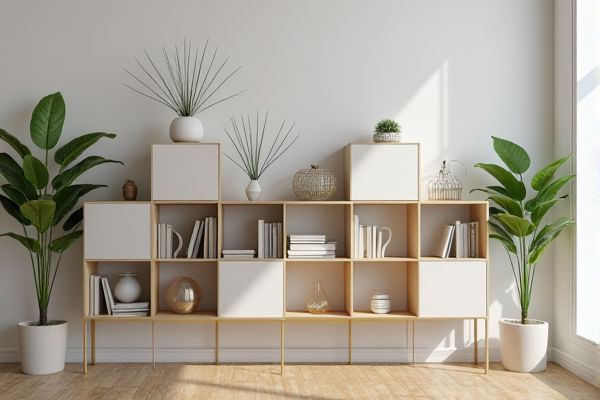
Display shelves provide an open, airy look ideal for showcasing decorative items and frequently accessed objects, while cube organizers offer structured compartments perfect for categorizing books, toys, or storage bins. Discover which option suits your space and style needs by reading the rest of the article.
Table of Comparison
| Feature | Display Shelf | Cube Organizer |
|---|---|---|
| Design | Open shelves, ideal for showcasing items | Grid-like compartments, perfect for sorting and storage |
| Functionality | Primarily displays decorative or frequently used items | Organizes books, toys, and various belongings systematically |
| Material | Wood, metal, or glass commonly used | Wood, plastic, or MDF typically preferred |
| Space Efficiency | Less efficient for small spaces due to open design | Optimizes space with multiple storage cubes |
| Customization | Limited; fixed shelves and sizes | Highly customizable with removable cubes and inserts |
| Best Use | Showcasing decor, art pieces, or collectibles | Organizing household items, office supplies, and toys |
| Price Range | Moderate to high depending on material and design | Affordable to moderate, budget-friendly options available |
Introduction to Display Shelves and Cube Organizers
Display shelves offer open, horizontal surfaces ideal for showcasing books, decor, and collectibles with easy accessibility and visibility. Cube organizers feature a grid of cubical compartments, providing versatile storage that can accommodate baskets, bins, or individual items of varying sizes. Both furniture types enhance organization and interior aesthetics but differ in design and functionality based on storage needs and space utilization.
Design and Aesthetic Comparison
Display shelves offer a sleek, open design with visible shelving that highlights decorative items and provides easy access, enhancing modern and minimalist aesthetics. Cube organizers feature enclosed cubical compartments that create a structured, grid-like appearance, adding a geometric and versatile look suitable for both functional storage and stylish displays. The choice between the two depends on whether the emphasis is on showcasing items with an airy feel (display shelf) or organizing belongings with defined sections and a contemporary vibe (cube organizer).
Material and Build Differences
Display shelves are typically crafted from solid wood or metal, offering a sturdy and durable build designed to showcase items with easy visibility. Cube organizers often utilize engineered wood or plastic composites, providing lightweight yet functional storage with individual compartments. Your choice depends on whether you prioritize the robust construction and classic appearance of display shelves or the modular, space-saving design of cube organizers.
Functionality and Storage Capacity
Display shelves offer open storage ideal for showcasing decorative items and easy access, while cube organizers provide versatile compartments that help categorize and maximize storage in smaller spaces. Cube organizers often feature adjustable inserts or bins, enhancing functionality by accommodating varied item sizes and improving organization. Your choice depends on whether you need visual display flexibility or compartmentalized storage efficiency.
Best Uses for Display Shelves
Display shelves are ideal for showcasing decorative items, collectibles, and artwork, enhancing the visual appeal of living rooms or offices. Their open design allows for easy access and visibility, making them perfect for highlighting personal treasures or frequently used items. You can maximize your space by using display shelves in areas where presentation and organization are both priorities.
Best Uses for Cube Organizers
Cube organizers excel in creating customizable storage solutions for books, toys, and decorative items, making them ideal for living rooms, playrooms, and offices. Their modular design allows you to rearrange or expand storage as your needs evolve, providing flexibility that display shelves typically lack. You can maximize space efficiency and maintain organization by choosing cube organizers for versatile and accessible storage options.
Space Optimization and Room Suitability
Display shelves maximize vertical space with open, tiered surfaces ideal for showcasing decor and frequently used items, making them perfect for living rooms or offices with ample wall space. Cube organizers provide modular, enclosed storage optimized for smaller or multifunctional rooms like bedrooms or dorms, allowing efficient use of floor space with customizable compartments. Both systems enhance room organization but cater to different spatial layouts and aesthetic needs, balancing accessibility and clutter control.
Durability and Maintenance
Display shelves are typically constructed from sturdier materials like solid wood or metal, offering superior durability and requiring minimal maintenance over time. Cube organizers often use lighter materials such as MDF or particleboard, which may be less resilient to heavy loads and prone to wear with frequent use. You should consider these factors when choosing between the two, as durability impacts both longevity and the frequency of upkeep needed to maintain a clean, functional storage solution.
Cost and Value Considerations
Display shelves typically offer higher upfront costs but provide greater value through enhanced aesthetics and larger storage capacity, making them ideal for showcasing items. Cube organizers are more cost-effective and versatile, allowing for customizable storage with modular inserts ideal for budget-conscious users. Your choice depends on balancing immediate expenses against long-term functionality and style preferences.
Summary: Which Storage Option Is Right for You?
Display shelves offer open storage ideal for showcasing decorative items and frequently used belongings, while cube organizers provide versatile compartments perfect for organizing books, bins, and smaller items. Your choice depends on your need for visibility versus compartmentalized storage, balancing aesthetics with functionality. Consider the space available and the type of items you want to store to determine which option best suits your living or workspace.
 homyna.com
homyna.com